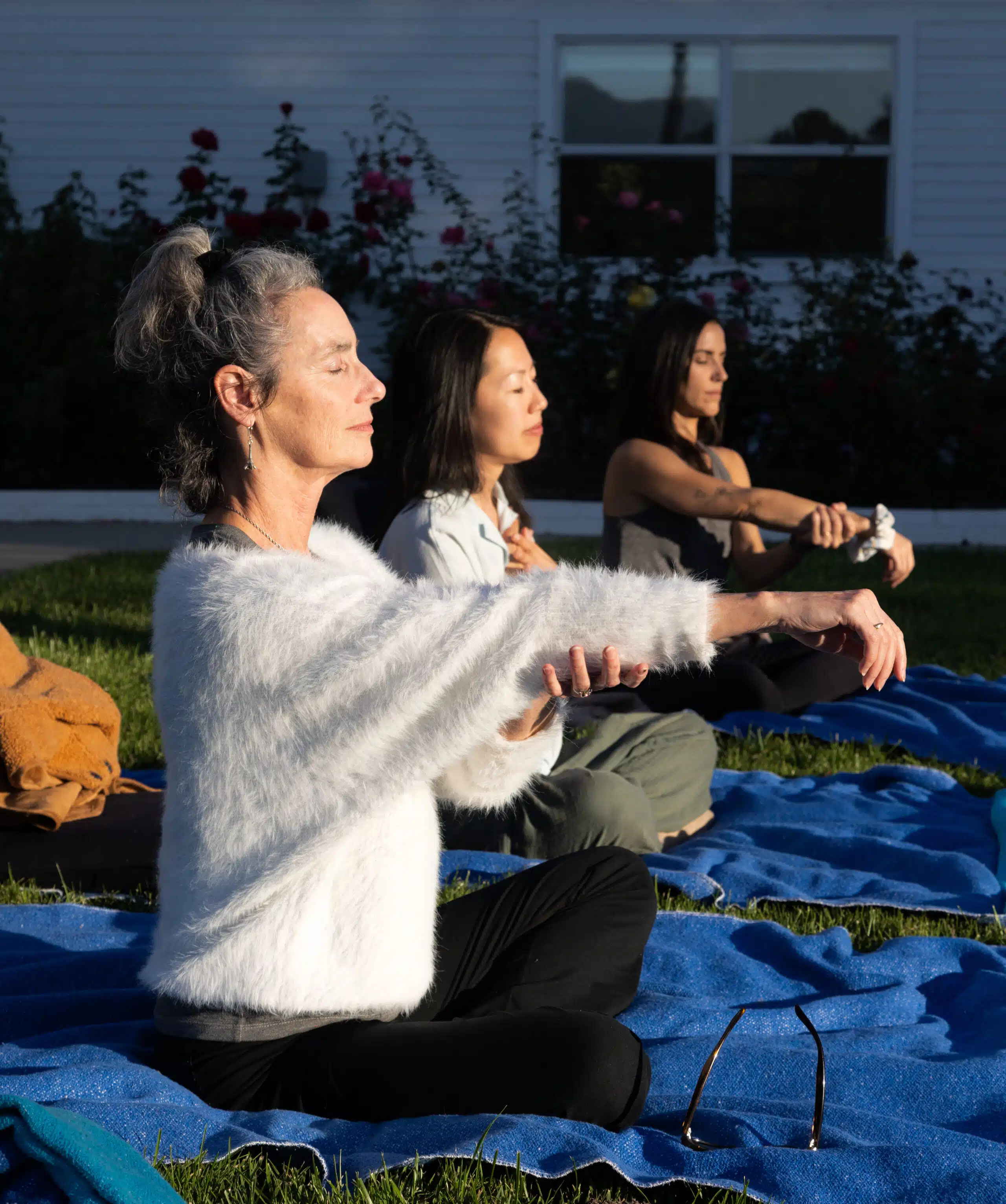Mindfulness vs Meditation and the Benefits of Each One
As meditation has been popularized in the West, mindfulness practices have become nearly as common. Many conceptions about mindfulness are new, made-up iterations of older traditions, like many forms of meditation these days are recent inventions in a pop culture setting. Vedic Meditation serves a very different purpose than mindfulness practices, and though the latter may be beneficial, they do not affect the body and stress levels in the same way that Vedic Meditation can.
We can start by defining the categories of meditation and defining mindfulness, then we can compare and contrast mindfulness vs meditation.

What is Mindfulness
Mindfulness is a practice of ‘shepherding one’s thoughts’ that developed in the past hundred years or so as an abstraction of Vipassana meditation. Mindfulness today most often refers to a category of practices or states where one spends time gaining awareness of their thoughts and emotions.
The practice involves focusing one’s awareness on the present moment, while calmly acknowledging and accepting one’s feelings, thoughts, and bodily sensations. It involves paying attention to experiences in a non-judgmental and accepting way, without getting caught up in thoughts or emotions. A popular definition of mindfulness has recently included the eyes-open practice of bringing your awareness and attention to your immediate surroundings and gently letting go of any thoughts that do not have to do with the present moment.
Mindfulness is a skill that can be developed through meditation, yoga, or other mindfulness-based practices and has been shown to have numerous benefits for mental and physical health. Mindfulness can help individuals cultivate greater awareness of their thoughts and emotions, leading to better self-understanding and more effective coping strategies. It is not able to address the root cause of thoughts, problems, or lower consciousness states, which we will talk about later in this post.
Vipassana
Mindfulness originated in a practice called Vipassana, which is a type of meditation that originates from ancient India and is based on the teachings of the Buddha. It is sometimes referred to as “insight meditation.” The goal of Vipassana is to develop self-awareness and an understanding of the nature of reality by examining one’s own thoughts, emotions, and physical sensations.
It is a practice of developing mindfulness and introspection through focused attention to the present moment. This helps individuals to gain insight into the impermanence of all things, leading to greater wisdom and peace of mind. Vipassana is a key practice in many Buddhist traditions, but it can also be practiced by individuals from any spiritual background.
Is Mindfulness from Buddha?
It is important to note that mindfulness practices are an abstraction of Vipassana and were most likely not taught by the Buddha. Buddhism as it exists today has many varying forms that resemble the Buddha’s teachings in varying degrees, with many of them attempting to reach enlightenment by copying the behaviors of one man rather than following the spiritual methods to develop a personal path of evolution.
In any case, mindfulness is a greater abstraction from any of Buddha’s original teachings and is now for the most part a method to manage thinking and examine one’s own thoughts and state for a greater sense of self-awareness.
The Types of Meditation
Mindfulness falls into the category of meditation that relies on concentration or directing thoughts. This is the style that requires a meditator to concentrate on not thinking, or to focus on a specific thing. Many people who experience overthinking or a busy mind find this form of meditation challenging and even frustrating – like trying not to think of pink elephants… and therefore thinking only of pink elephants.
This form of meditation may have the participant concentrate on their breathing, on their immediate surroundings, on body sensations, on emotions coming up, or on thoughts all with a non-judgmental and accepting attitude. Over time, the mind may be able to concentrate more effectively to think about only one thing, like training a muscle. This form of meditation is basically focus training, which works well for some people and not so well for others.

How Concentration and Vedic Meditation are Different
Concentration is the opposite of Vedic Meditation, since Vedic Meditation is effortless and thoughts are allowed.
The Vedic Meditator does not force their mind to do anything. They have a personalized mantra that is a meaningless sound, which naturally arises in their awareness and subtly floats away when thoughts appear. The transition back and forth from the mantra to the thoughts requires no effort, and the thoughts are no measure of the ‘depth’ or effectiveness of the meditation.
Thoughts are allowed in Vedic Meditation, meaning that we don’t have to notice them, accept them, judge them, or avoid them. They can happen in any way they appear in our minds, and we can attend to them for as long as they hold our mental attention. Eventually, the mantra will float back into the awareness and we can effortlessly think of that meaningless sound.
At times, the mantra and the thoughts arise at the same time, and we don’t have to ascribe any meaning to any of them.
No matter how emotional or dramatic our thoughts may be, we don’t have to ascribe any meaning to them. We don’t have to love them, accept them, or change them in any way. Our thoughts represent the release of stress in Vedic Meditation, so we can let them pass easily and innocently, with no force or concentration involved. This is possible with the use of a personalized Bija mantra given to each Vedic Meditator by a qualified Vedic Meditation instructor.
The mantra spontaneously repeats and draws the mind inward to more and more restful states. As thoughts arise, stress releases, and the body is still able to relax further into rest. With concentration, however, the mind is unable to rest.
Concentration and force keep the mind alert. This is the main difference between mindfulness and meditation: one forces the mind to concentrate to train a coping mechanism, and the other is effortless and releases stress.
The Benefits of Each Type
Though concentration may result in a better ability to focus out of intense mental training, Vedic Meditation allows the mind to focus effortlessly as it feels the need to distract itself less and less.
Incessant thinking comes from an unhappy mind. A mind that is stressed will endlessly search for something to make it feel better. Concentration is like forcing the mind to stop searching for something satisfying, which is futile. Even when intense focus is established, the stress and unhappiness are still in the background.
The Vedic Meditator experiences effortless focus once their meditations have led them to experience effortless thoughtlessness. The mantra– a meaningless sound that effortlessly pulses in the background of the mind– will charm the mind to become quieter as it becomes more and more subtle through meditation. Eventually, the mantra vanishes, and the mind is left in a state of pure consciousness or being. This is a wholly satisfying state for the mind to experience, so the mind does not generate more thoughts to remedy its dissatisfaction.
With repetition, thoughtlessness will be more and more effortless outside of meditation as well, which means the mind can focus easily and without effort. It also means the mind can feel content, quiet, and happy without effort.
The Goal of Vedic Meditation vs Mindfulness
Mindfulness training is usually intended to help practitioners gain awareness of their emotions and thoughts so they can form better coping strategies. Rather than removing the stress or addressing the root cause, mindfulness helps people choose how they will respond with a force of willpower and habit.

What is the Difference Between Mindfulness and Meditation
With Vedic Meditation, the awareness of our thoughts and feelings effortlessly grows along with our consciousness as we transcend thought and interact with the field of pure Being. The steady release of stress memories from our body slowly removes the triggers and built-up stress that we would otherwise have to cope with. Without the stress, and with the influence of thoughtlessness and totality occurring twice each day, our self-awareness grows naturally and we have less and less need to cope in the first place.
One other key difference is that with mindfulness-based stress reduction practices, you may have any number of recommended body positions: from no recommendation of body position while you practice waking mindfulness throughout your day, to laying down and closing your eyes for a session. This is not the case with Vedic Meditation.
Vedic Meditation is taught while sitting down with the back supported and the head and neck unsupported, sitting upright in a comfortable position. There is no special leg crossing or hand placement with Vedic Meditation, the only important thing is to be sitting upright quite comfortably without any headrest behind the neck or head.
This is in order to maintain a waking state while we take our body effortlessly into the hypo-metabolic state – a state where the body can rest 5x more deeply than sleep and still be mentally awake. The contrast of a deeply relaxing meditation with a waking mind allows the body to release far more stored stress at a greater rate than any concentration-based meditation can provide.
Mindfulness Versus Meditation: Can You Do Both?
Vedic Meditation is a totally innocent practice that can neither harm any other practice nor be harmed by another practice. In order to correctly practice Vedic Meditation and receive all of the benefits, it is important not to mix techniques. Each Vedic Meditation session should be practiced independently from any other techniques, with the assigned Bija Mantra and according to the instructions of your teacher. Outside of the twice daily twenty-minute sessions, Vedic Meditators can practice any other kinds of spirituality, thinking, or any other activities in general.
The nature of Vedic Meditation is to clear stress out of the body, making it easier to focus and get the most out of other kinds of practices. We do tend to find with Vedic Meditators that after a certain time of consistent practice, other meditation or mindfulness practices tend to drop away.
There is a trend in Vedic Meditators that two sessions of twenty-minute meditations with the mantra satisfy the desire for evolution and improve mental and emotional health sufficiently. Being that most people have jobs and families and demands on their time, 40 minutes of meditation collectively per day tends to be enough of a commitment without adding other practices on top.
If a meditator is looking for the most benefits possible out of the time they dedicate each day to meditation, then they will want to bypass controlling the mind and move to a style that transcends thought and allows the deep release of stress from the body.
Experiment with Mindfulness vs Meditation
If you’d like to see real-time proof showing the difference between meditation and mindfulness, then practice a mindfulness technique every day for one week before taking the Learn to Meditate Course. Compare the benefits and results of your two separate weeks of practice, and see which one accomplishes more of your desired results.
Learning Vedic Meditation
To receive your own mantra and start a meditation practice of your own, register for the Learn to Meditate course. You’ll learn how Vedic Meditation affects the mind and body, and why releasing stress and experiencing transcendence ultimately leads to the slow and steady expansion of one’s consciousness.







